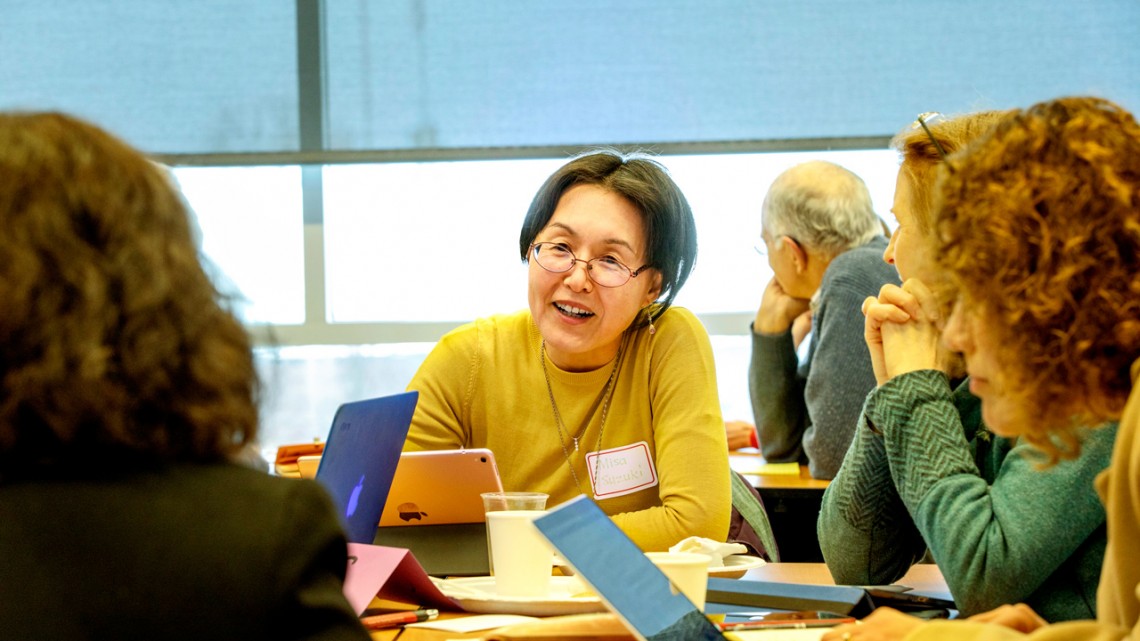
Misako Suzuki, senior lecturer in Asian studies, participates in the faculty “Lunch & Learn” session Jan. 16, discussing ideas and tool for the implementation of the Canvas learning management system.
‘Lunch & Learn’ sessions focus on how to use Canvas
By Dave Winterstein
With Cornell’s transition from Blackboard to Canvas as its academic learning management system now complete, instructors are exploring how to use Canvas to further enhance student learning.
“Our experience with our pilot faculty suggests that many faculty take one semester to settle in before trying new features,” said Rob Vanderlan, Canvas team co-leader and senior associate director at the Center for Teaching Innovation.
To help faculty explore and implement new ideas and tools, the Canvas team is building a community of practice through its “Lunch & Learn” programs, which ran Jan. 8 for course administrators and Jan. 16 for faculty.
“Our hope is that Canvas will be more than just a class organization tool. It can be a new platform to facilitate learning,” said Julia Thom-Levy, professor of physics and vice provost for academic innovation, said in opening the faculty program.
Nearly 60 instructors gathered Jan. 16 to hear Benjamin M. Finio, lecturer in the Sibley School of Mechanical and Aerospace Engineering, and Robert J. Bloomfield, the Nicholas H. Noyes Professor of Management in the Cornell SC Johnson College of Business, describe their innovative uses of Canvas.
Finio had polled students on different methods of displaying information in Canvas.
“I wanted to find out what [presentation method] was most useful to improve education and reduce friction for students,” he said. Students preferred course content presented in modules, he found.
Bloomfield teaches hybrid executive MBA courses with participants located around the world, creating a whole new set of challenges in using Canvas.
“Because I have a very distributed classroom for my courses, the Canvas discussion feature was very helpful,” he said. “A student told me [the discussions] brought the class closer together, which means a lot. I love the Canvas app, too. I set it to send me alerts, which really helped me keep on top of discussions in my class.”
Participants also were interested in Bloomfield’s grading system, which awards points to students for engaging with the course material. He uses Canvas quizzes, including one about the information in his syllabus, to help students gain experience using the course ideas.
All those points add up to what Bloomfield calls “rewards for taking actions we can control,” a key management accounting principle underlying his course.
In the Jan. 8 session, 35 administrative assistants from around campus gathered to discuss how they solved problems and hear presentations from the Canvas team on new tools, such as Gradescope and Canvas Commons.
“There are resources that I need to tap into so I can refer faculty to them,” said Lisa Jones, administrative assistant at the Cornell Institute for Public Affairs. “While there is always online documentation for technology tools, talking through Canvas features [at the Lunch & Learn] was a good introduction and it helped raise my comfort level as a user.”
Said Emily Cotman, undergraduate programming coordinator in the Department of Fiber Science and Apparel Design: “Now I feel like I can tell faculty about these tools to help them solve issues they may have.”
Both faculty and staff said creating a sense of belonging and networking across Cornell was as important as learning how their peers are using Canvas.
“Coming together to see what faculty from all over campus are doing with Canvas is a very inspiring thing,” said William E. Bemis, professor of ecology and evolutionary biology.
The CTI Canvas Lunch & Learn series will continue at the end of spring semester. Faculty and course administrators can contact CTI for further assistance with Canvas and other teaching questions.
Dave Winterstein is a communication assistant for the Center for Teaching Innovation.
Media Contact
Get Cornell news delivered right to your inbox.
Subscribe
